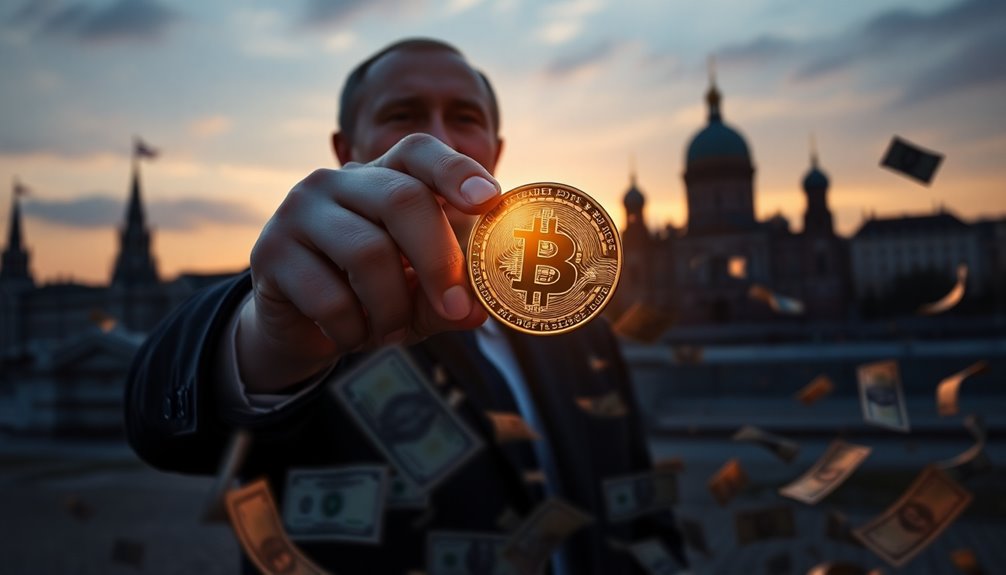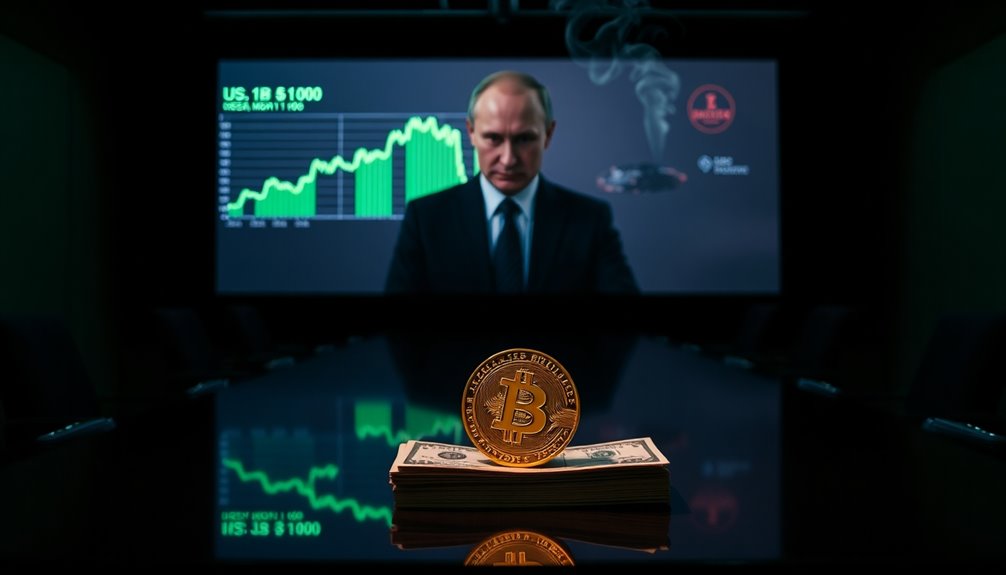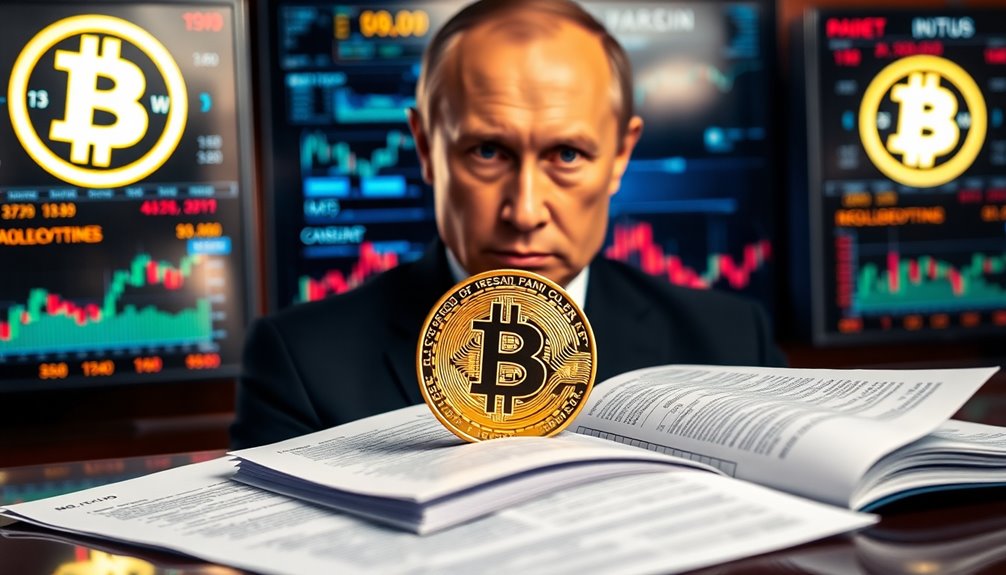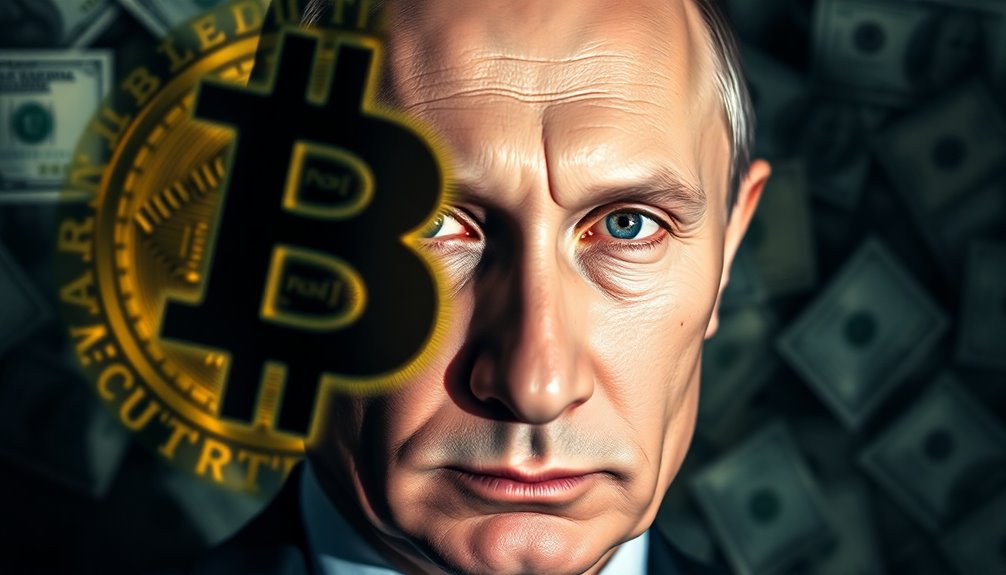Putin's push for Bitcoin is a strategic move that could challenge the dollar's dominance. By endorsing cryptocurrency, he's aiming to boost Russia's economic resilience amid Western sanctions and global financial instability. With around 86% of Russians familiar with digital assets, there's a strong public interest in adopting crypto. New regulations also make Russian mining operations more viable. As crypto transactions soar, it's clear that this shift could influence international markets. The implications are profound, suggesting the dollar's reign may face serious competition. Stick around to discover more about Russia's evolving crypto landscape and its global impact.
Key Takeaways
- Putin views Bitcoin as a potential global reserve currency to diminish the dominance of the US dollar amid sanctions.
- Russia's regulatory framework promotes cryptocurrency as property, fostering economic resilience and attracting investment in the sector.
- High public interest in cryptocurrencies, with 20% of Russians already engaged, signals a shift towards alternative financial systems.
- Increased crypto transactions, projected to surge with new laws in 2024, may challenge traditional currency dynamics in international trade.
- Russia's significant mining operations and global hash rate position it as a key player in the evolving cryptocurrency landscape, impacting the dollar's influence.
Putin's Vision for Bitcoin

Putin's vision for Bitcoin reflects a strategic pivot aimed at reshaping Russia's economic landscape. By endorsing Bitcoin as a potential global reserve currency, he seeks to diminish the influence of the US dollar, especially in light of the $300 billion in Russian reserves that were frozen due to Western sanctions.
This move positions cryptocurrency as a viable alternative, aimed at reducing financial inefficiencies and enhancing economic stability. As the US government leverages dollar dominance for political agendas, Russia's embrace of Bitcoin provides a way to circumvent such control.
Historical instances of frozen reserves underscore the urgent need for alternatives to mitigate economic risks. To support this vision, a regulatory framework has emerged. Laws have been signed to tax cryptocurrency mining and transactions, recognizing digital assets as property under the Tax Code.
With income tax rates set at 13% and 15%, and a corporate tax rate of 25% for crypto-related income, Russia is laying the groundwork for a structured crypto economy. Furthermore, the growing acceptance of cryptocurrencies among world leaders amplifies this shift toward digital assets. Public engagement shows promise, with nearly 20% of Russians having used cryptocurrency, indicating a growing interest in digital assets as a means of savings and investment.
Economic Drivers Behind Crypto Adoption

As Russia moves to integrate Bitcoin into its economic framework, various economic factors are driving the global surge in cryptocurrency adoption. Inflation crises across many nations push individuals to seek alternatives for wealth protection, making cryptocurrencies an appealing choice. Additionally, the total value of all cryptocurrencies reached $0.25 trillion as of late 2019, indicating a growing interest in digital assets.
When interest rates rise, the appetite for high-risk assets like crypto can wane, but economic instability, including high unemployment, often compels people to explore alternative financial avenues.
A low trust in traditional banks and the financial system fuels the adoption of crypto infrastructure. In regions where distrust prevails, Bitcoin finds a more welcoming audience.
Furthermore, cryptocurrencies serve as a hedge against inflation and financial instability, reinforcing their appeal in uncertain times.
On the flip side, in areas with significant unbanked populations, crypto adoption tends to lag. The existing financial infrastructure plays an essential role, as greater risk tolerance can lead to increased Bitcoin infrastructure development.
In many developing nations, cryptocurrencies provide critical financial inclusion, giving people access to resources that traditional banking often overlooks.
These economic drivers are reshaping the financial landscape, paving the way for a new era of digital currency.
Regulatory Landscape in Russia

Russia's regulatory landscape is rapidly evolving to accommodate the growing presence of cryptocurrency within its economy. The country recognizes cryptocurrency as property under its Tax Code, which greatly impacts how you engage with this digital asset. Mining operations are exempt from value-added tax (VAT), but they must report to local authorities, facing fines of 40,000 rubles for non-compliance. To capitalize on the booming industry, Russia is expected to collect up to 200 billion rubles from miners annually.
Here's a concise overview of the key regulatory aspects:
| Aspect | Details |
|---|---|
| Taxation on Sales | 13% up to 2.4 million rubles; 15% above |
| Corporate Tax Rate | 25% for entities in crypto activities |
| Mining Compliance | Registration with Rosfinmonitoring |
| Expected Revenue | Up to 200 billion rubles from miners |
The Central Bank of Russia (CBR) maintains oversight, ensuring compliance and regulation of transactions. While domestic payments in cryptocurrency remain banned, you can legally mine and use crypto for international transactions. This structured regulation aims to foster a secure environment for cryptocurrency activities while enhancing state-backed exchanges to boost adoption.
Impact on Cryptocurrency Transactions

The recent legislative changes in Russia are set to considerably impact cryptocurrency transactions, particularly in the domain of cross-border payments. With new laws allowing crypto mining and international payments, effective from August 8, 2024, you can expect a surge in crypto activity. Trials for these payment methods are slated to kick off in September, with the Central Bank of Russia overseeing the process. In 2023, Russian citizens processed around $52.1 billion worth of transactions, indicating a substantial appetite for crypto. With approximately 13 million Russians engaging in cryptocurrency operations, the potential for growth is immense. The anticipated use of stablecoins for international transactions will likely streamline processes and enhance value stability, especially as the National Payment Card System plays a vital role in this trial phase. Furthermore, the new laws expand the Central Bank of Russia's regulatory control over cryptocurrency transactions, ensuring oversight and compliance. However, challenges remain. Technical complexities and value fluctuations could hinder seamless transactions, while the Central Bank may impose restrictions if financial stability is threatened. Additionally, energy consumption limits and potential regional bans on mining could impact the scalability of these initiatives. The success of Russia's crypto endeavors will heavily depend on international cooperation, particularly with BRICS nations. Moreover, the introduction of a Bitcoin IRA could provide Russian investors with a tax-efficient vehicle for cryptocurrency holdings, further driving demand.
Future of Crypto in Russia

Looking ahead, the future of cryptocurrency in Russia appears both promising and complex. The government has laid a legislative framework that recognizes digital currency as property under the Tax Code, exempting mining and sales from value-added tax. However, as a miner, you'll need to register with local authorities and report your activities or risk hefty fines. While cryptocurrency mining is legalized, the ban on using cryptocurrencies for payments still stands, and advertising for crypto services remains prohibited.
The economic implications are significant, as the mining sector could generate up to 200 billion rubles annually. This potential revenue might help Russia navigate global sanctions and reduce dependence on the US dollar. Additionally, the country's position as the third-highest hash rate on the Bitcoin network showcases its growing influence in the global crypto landscape. To fully leverage this growth, miners should consider implementing risk management strategies to protect their investments.
Yet, proposed tariff increases on energy for miners could dampen this growth. Public interest in cryptocurrencies is high, with 86% of Russians familiar with them. Russia ranks 13th on the Chainalysis Global Adoption Index, indicating increasing engagement. The presence of Bitcoin ATMs across major cities further highlights this trend. Overall, while the regulatory landscape poses challenges, the growing interest and potential for cross-border payments suggest a dynamic and evolving crypto market in Russia.
Frequently Asked Questions
How Does Putin's Bitcoin Stance Affect Global Cryptocurrency Regulations?
Putin's stance on Bitcoin impacts global cryptocurrency regulations by encouraging some nations to adopt more crypto-friendly policies while prompting others to tighten regulations.
You'll see increased international discussions about standardizing regulations, aiming for consumer protection and stability.
As cryptocurrencies gain traction for cross-border payments, countries might enhance their regulatory frameworks to address risks and opportunities, ultimately shaping the future landscape of digital currencies and investor sentiment around the world.
What Are the Environmental Impacts of Russia's Crypto Mining Activities?
Did you know that Bitcoin mining emitted over 85.89 million metric tons of CO2 during 2020-2021?
In Russia, crypto mining greatly contributes to greenhouse gas emissions, pushing global warming concerns. The energy-intensive process mainly relies on fossil fuels, leading to increased carbon footprints.
Additionally, mining operations use vast amounts of water, threatening local supplies. The e-waste generated from outdated hardware further exacerbates environmental damage, jeopardizing ecosystems and community health.
How Has Public Opinion in Russia Shifted Towards Cryptocurrency?
Public opinion in Russia has shifted markedly towards cryptocurrency, with 9 out of 10 people familiar with it.
You'll notice that 86% express interest, despite complex regulations.
As Russians increasingly engage with Bitcoin and Ethereum, the nation's ranking in the Global Adoption Index has improved.
Economic sanctions have pushed many to explore crypto for international payments, reflecting a growing acceptance and recognition of its potential benefits amidst evolving financial landscapes.
What Role Do Russian Banks Play in the Crypto Landscape?
Russian banks play an essential role in the crypto landscape by regulating transactions and facilitating cross-border payments.
They collaborate with the Central Bank of Russia to monitor and restrict high-risk activities, ensuring financial stability.
You'll find that banks enable users to exchange funds for crypto, even with sanctioned institutions.
As they adapt to favorable regulations, these banks spur investment and innovation, helping to grow the crypto market considerably in the coming years.
Are There Any Partnerships Between Russia and Other Countries Regarding Crypto?
In the dance of global finance, you'll find Russia forging partnerships with BRICS nations, weaving a tapestry of collaboration.
Together, they're exploring crypto initiatives, creating a bridge for trade beyond the dollar's grasp.
By embracing cryptocurrencies, these countries aim to strengthen their economic ties and reduce reliance on Western networks.
It's a strategic move, enhancing resilience and fostering stability, where each step resonates with a promise of a more interconnected financial future.
Conclusion
As you witness Putin's bold moves in the crypto world, it's hard not to feel a mix of excitement and anxiety. The potential shift away from the dollar could reshape our financial landscape. Coincidentally, just as you're contemplating this change, you might find yourself reflecting on how cryptocurrencies have already altered the way you think about money. In this unfolding drama, the future of finance feels both thrilling and uncertain, leaving us all to wonder what lies ahead.










